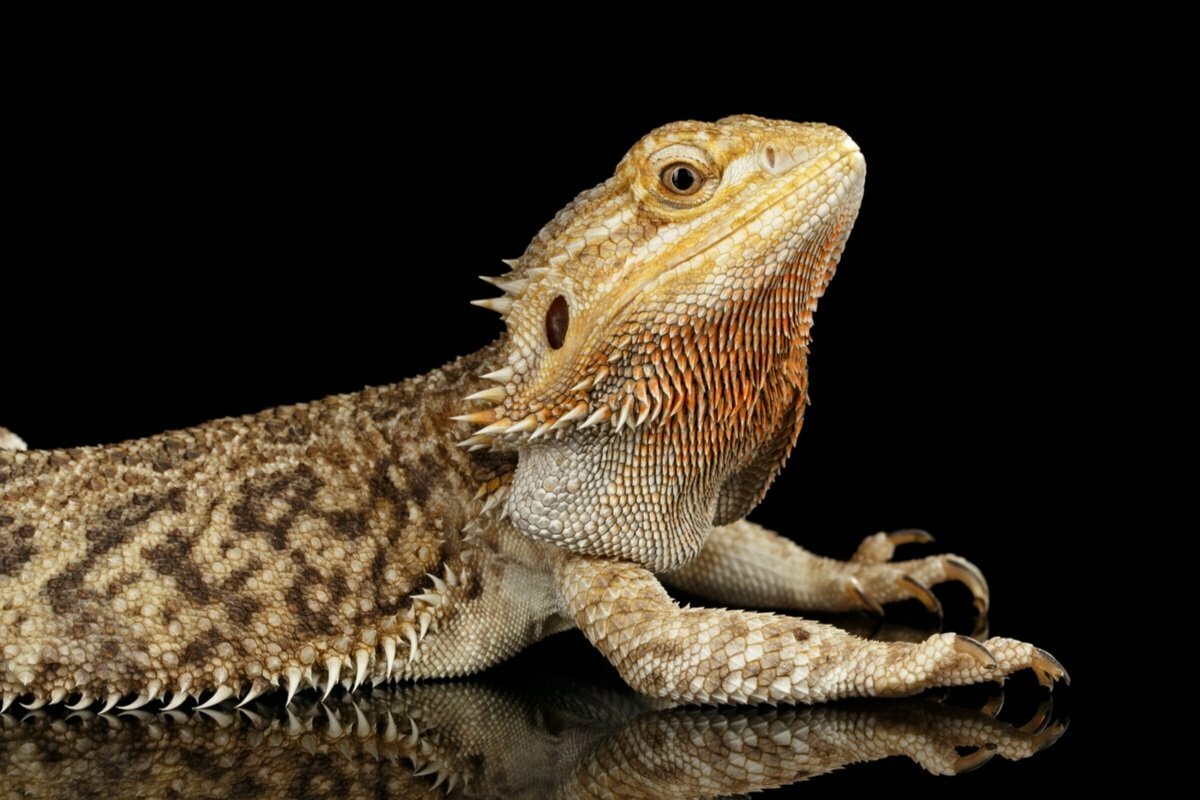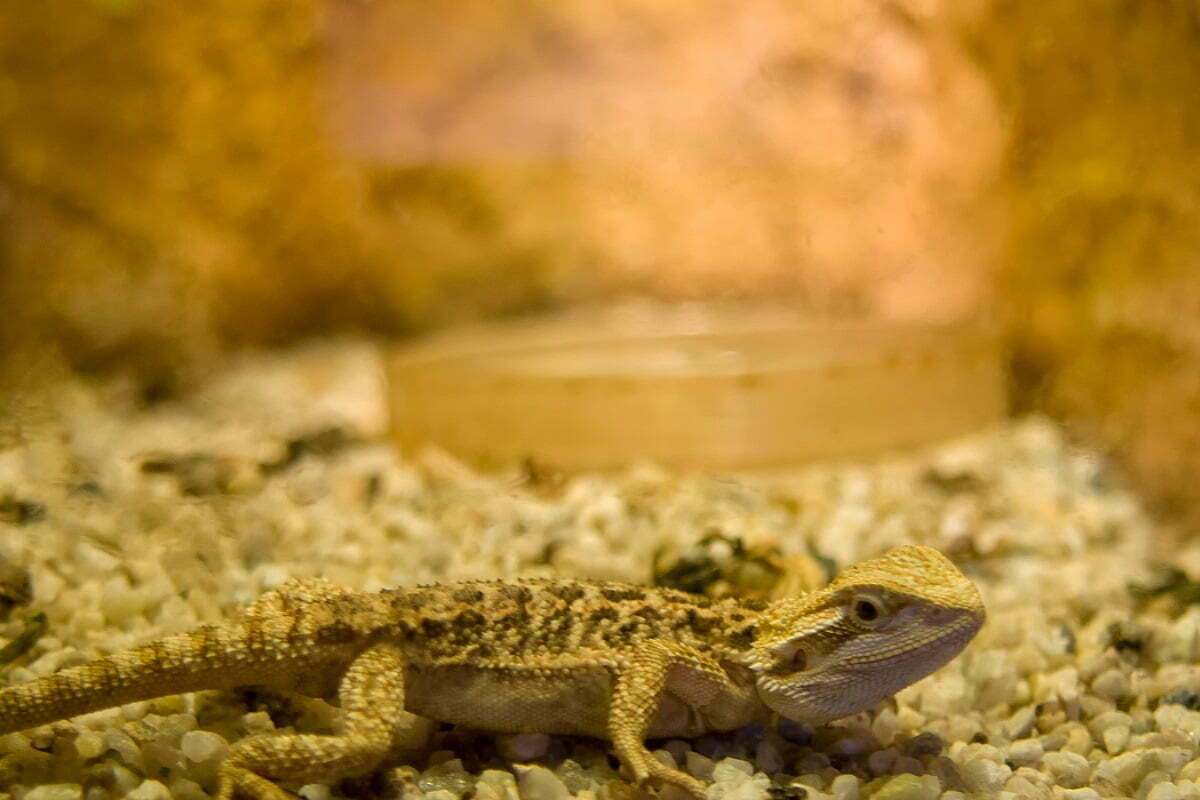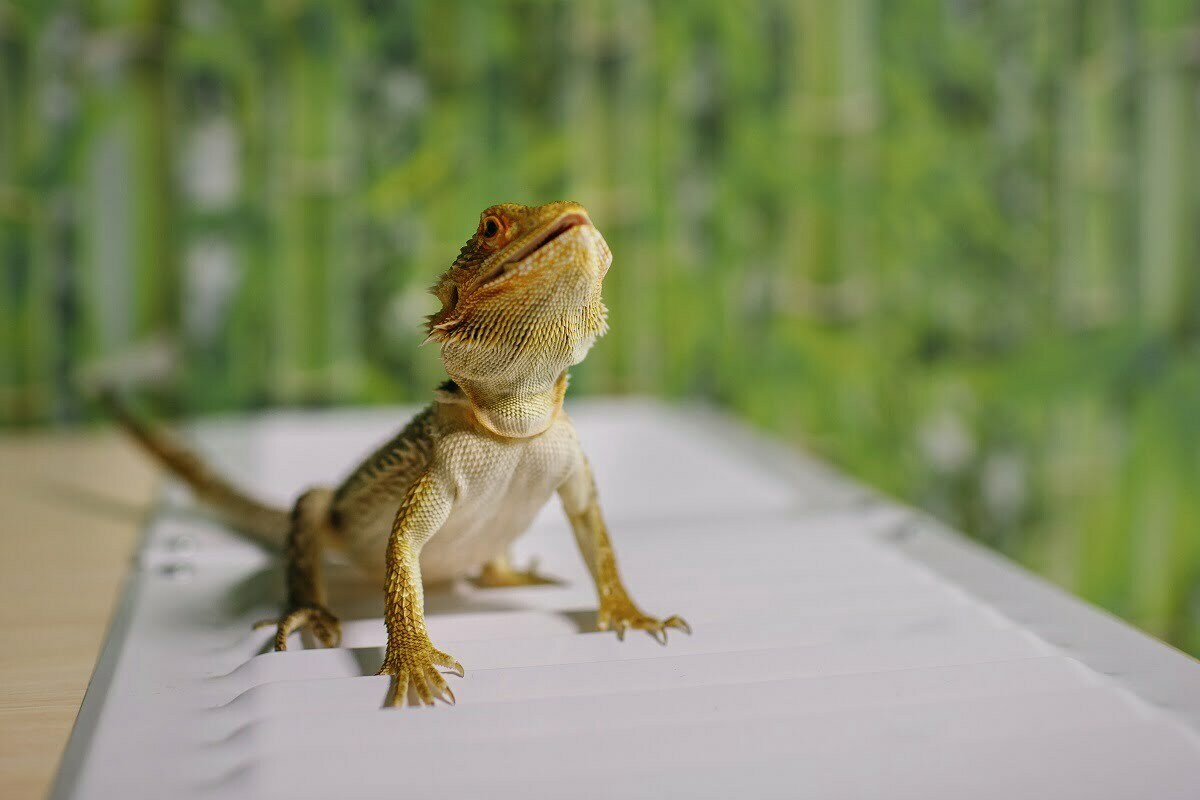The bearded dragon is surprisingly one of the most common exotic pets kept in the United States. Still, many owners find themselves with many questions after bringing their new reptile roommates home.
One of the biggest concerns new owners of bearded dragons have is related to urination.

Specifically, owners worry that they can’t see any evidence of their bearded dragon urinating and fear that there is something medically wrong with their pet.
If you’re unsure whether your bearded dragon is peeing or if these animals are even supposed to pee, you’re in the right place.
We’re going to be explaining how bearded dragons eliminate waste, what you should look out for, and everything else you need to know when it comes to bearded dragons and urination.
Is A Lack Of Pee Concerning In A Bearded Dragon?
Many first-time bearded dragon owners assume that if they can’t see liquid urine in their dragon’s enclosure, their dragon must not be eliminating waste and, therefore, must be unwell.
However, if you can’t see any pee, don’t panic. This isn’t a sign of poor health – it’s actually very normal.
Bearded dragons don’t pee in the same way as humans do.
While humans expel liquid waste in the form of urine, bearded dragons have a need to keep any liquids they ingest inside their bodies due to their hot living environments.
If bearded dragons urinate the same as humans, they will quickly become dehydrated and sick.
Instead of urine, bearded dragons expel waste in the form of solid uric acid. So, if you’re looking in your dragon’s enclosure and can’t see any puddles, don’t panic and go running to the vet.
Chances are, your pet is absolutely fine.
How To Identify Bearded Dragon Urine
So, if pee doesn’t look the same in bearded dragons as it does in humans, what does a bearded dragon’s pee look like?
The bearded dragon version of urinating is expelling a substance called uric acid. This should be white in color and have a dry, powdery consistency.
You will be able to differentiate uric acid from your bearded dragon’s excrement because bearded dragon poop is similar in consistency to the waste of other animals.
Interestingly, bearded dragons often pee and poop at the same time. When you notice your bearded dragon doing a poo, keep an eye out for uric acid being expelled simultaneously.
If you can identify both, it’s safe to assume that your dragon’s digestive system is working properly.
Ideal Bearded Dragon Urine Color

As we have mentioned, a bearded dragon’s uric acid should ideally be white. However, some owners also report seeing yellow uric acid in their dragon’s vivarium. Is this cause for concern?
Yellow uric acid could be a sign that your bearded dragon is dehydrated.
If this persists over a long time, there could be health consequences for your dragon, so you should take some steps to increase your pet’s hydration levels.
Check the ambient temperature in your beardy’s enclosure. If it’s hotter than 85 degrees Fahrenheit (75 degrees at night), this could be the reason for your dragon’s dehydration.
Turn the heat lamps down to a more comfortable temperature. The basking spot can be a bit hotter (up to 100 degrees), but if it’s hotter than this, take steps to make it cooler.
Always make sure you have a thermometer to monitor the temperature.
Make sure that your bearded dragon always has plenty of water to drink. Its drinking bowl should never be empty.
If these changes don’t solve the problem, it’s possible that your dragon has too much calcium in its diet. If you think this might be the case, speak to your vet.
They will be able to recommend dietary changes to ensure that your beardy’s calcium consumption is optimal.
Optimal Consistency For Bearded Dragon Pee
Changes in the consistency of your bearded dragon’s uric acid can also give you clues about its health.
As we said earlier, the uric acid produced by your bearded dragon should be dry and powdery.
However, it should not be overly hard. If the uric acid is extremely firm and solid, this could be another symptom of dehydration, and you will need to check the temperature and water levels in your pet’s enclosure.
One thing you can try is giving your dragon a warm bath.
The water needs to be warm so as not to send your dragon into hypothermic shock, but the moisture can help rehydrate your beardy through its skin, and you may notice a difference in pee consistency.
How Often Should Bearded Dragons Pee?
On average, you should expect your bearded dragon to pee approximately once a day. Remember, bearded dragons typically pee at the same time as they poop, which is roughly once daily.
With that being said, you probably don’t need to worry if your bearded dragon is producing uric acid slightly more or less frequently because many factors can impact this, such as age.
Baby bearded dragons pee more often than adults. Sometimes, they may pee as many as 3 times a day. As they get older, they pee less often, producing uric acid about once per day or even a bit less.
Your bearded dragon’s uric acid production may also be impacted by factors such as diet, hydration levels, or even stress.
The Relationship Between Bearded Dragon Pee And Stress

Many of us are, unfortunately, familiar with the experience of stress impacting our digestive systems. However, for bearded dragons, stress can impact their ability to produce uric acid.
If you think that your bearded dragon might be struggling to pee because of stress, you could try minimizing its exposure to potential stressors. These include:
- Loud noise
- Being too hot or too cold
- Other bearded dragons or animals
Frequently Asked Questions
Do I Need To Bathe My Bearded Dragon?
Some reptiles, like snakes, need bathing fairly regularly so that they don’t start to smell bad or get sick. However, bearded dragons don’t typically need bathing.
Remember, their pee is fairly solid, so it’s not as if they are urinating on themselves and requiring a clean-up every time.
With that being said, if you think your beardy might be dehydrated, you could try giving it a bath in warm water.
This can also be helpful if you think your bearded dragon might be impacted (unable to poop because of constipation) because it can help to loosen stool through extra hydration.
What Can I Do If My Bearded Dragon Is Stressed?
It can be difficult to tell if your bearded dragon is stressed, but since stress can impact your dragon’s health, it’s important to be aware of the signs and know how to fix the problem.
A stressed bearded dragon may lose its appetite, start behaving aggressively, and develop dark stripes on its belly, known as ‘stress marks.’ They might also stop moving around and bask less than usual.
To help your dragon to calm down, you should try to identify the source of its stress.
If you have just adopted or purchased your dragon, they may simply be stressed due to a new environment, in which case, you may find that it relaxes after a few days or weeks.
Try to minimize noise near your dragon’s enclosure and keep any other pets away. Avoid housing several bearded dragons together, as they could stress each other out.
How Can I Tell If My Bearded Dragon Is Sick?
If a lack of liquid urine is not a sign of ill health in bearded dragons, you may be wondering what is.
If you find that the color or consistency of your bearded dragon’s uric acid changes significantly and does not return to normal even though their enclosure’s temperature is normal and they have plenty of water, you should take your pet to the vet just to make sure nothing is wrong.
Yellow ‘pee,’ for example, can be a sign of too much dietary calcium, and your vet can show you how to avoid this.
Things like loud breathing, weight loss, not pooping or pooping too many times per day, discolored skin, acting lethargic, or discharge from any part of the body can all be signs of illness in bearded dragons.
Therefore, if you notice any of these symptoms, it’s time for a visit to the vet.
Conclusion
Although first-time owners may be alarmed to discover that their bearded dragon is not producing any liquid waste, it is normal for these reptiles not to pee in the same way as humans do.
Bearded dragons produce a form of concentrated uric acid called urate instead, which is white, powdery, and solid – although it should not be too hard.
An adult bearded dragon should produce uric acid about once per day. You may notice this at the same time as you see your bearded dragon poop.
If your bearded dragon’s uric acid is yellow or is being expelled infrequently, you should check its environmental temperature and make sure it has access to water.
Try bathing your dragon in warm water and minimizing stress in its environment. If none of these things help, see your vet for advice.
